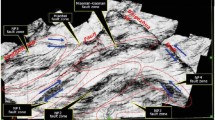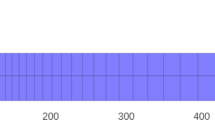Abstract
Formation damage is commonly known as a great cause for the production decline, owing to the unclear formation damage mechanisms under the reservoir geological and engineering conditions. This paper aims to develop a formation damage control technology during drilling for the protection of the natural productivity of saline-lacustrine reservoir. Reservoir geological characterization is first presented, including formation mineralogy, petrophysical properties, and fracture developing features. Fluid and stress sensitivity and in situ drilling fluid damage are experimentally evaluated under the simulated reservoir conditions. Successively, formation damage mechanisms during drilling are comprehensively summarized based on the evaluation results. It is believed that lost circulation is the main reason for formation damage, which further induce other damage. Given the formation damage mechanisms, principles of formation damage control technology for saline-lacustrine carbonate reservoir are explored, and in situ drilling fluids are optimized. The optimized drilling fluids are validated by lab experiments and field trials in Qaidam Basin. Field trials indicate that daily decline rate of productivity is decreased and per-well daily yield is increased by 7.7% year-on-year by using the optimized drilling fluids. This work could provide an effective guideline of formation damage control for saline-lacustrine reservoirs.









Similar content being viewed by others
References
Belfield WC (1988) Characterization of naturally fractured carbonate reservoir: Lisburne field, Prudhoe Bay, Alaska. Presented at the SPE Annual Technical Conference and Exhibition, Houston, Texas, USA, 2-5 October
Bennion DB (2002) An overview of formation damage mechanisms causing a reduction in the productivity and injectivity of oil and gas producing formations. J Can Pet Technol 41(11):29–36
Civan F (2007) Formation damage mechanisms and their phenomenological modeling-an overview. Presented at the European formation damage conference. Scheveningen, the Netherlands. 30 May-1 June
Dong C, Pan Z, Ye Z (2015) Dependence of gas shale fracture permeability on effective stress and reservoir pressure: model match and insights. Fuel. 139:383–392
Esrafili-Dizaji B, Rahimpour-Bonab H (2009) Effects of depositional and diagenetic characteristics on carbonate reservoir quality: a case study from the South Pars gas field in the Persian Gulf. Pet Geosci 15(4):325–344
Esteban M, Taberner C (2003) Secondary porosity development during late burial in carbonate reservoirs as a result of mixing and/or cooling of brines. J Geochem Explor 78-79:355–359
Gray DH, Rex RW (1966) Formation damage in sandstones caused by clay dispersion and migration. Clay Clay Miner 14(1):355–366
Huang C, Zhao F, Yuan J, Wu L, Chen G (2016) The characteristics of dolomite reservoir in saline lacustrine basin, Qaidam, China. Carbonates Evaporites 31(3):307–317
Huang C, Cao Z, Zhao F, Ni X, Liu Y, Bai Y (2018) Porosity characteristics of the Eocene mixed-sediment reservoirs in the saline lacustrine basin, Qaidam, China. Carbonates Evaporites 33(4):601–612
Kalantariasl A, Bedrikovetsky P (2014) Stabilization of external filter cake by colloidal forces in a “well–reservoir” system. Ind Eng Chem Res 53(2):930–944
Kang Y, You L, Xu X, Liao Z (2012) Prevention of formation damage induced by mud lost in deep fractured tight gas reservoir in Western Sichuan basin. J Can Pet Technol 51(01):46–51
Kang Y, Xu C, You L, Yu H, Zhang D (2014) Temporary sealing technology to control formation damage induced by drill-in fluid loss in fractured tight gas reservoir. J Nat Gas Sci Eng 20:67–73
Kang Y, Tan Q, You L, Zhang X, Xu C, Lin C (2019) Experimental investigation on size degradation of bridging material in drilling fluids. Powder Technol 342:54–66
Li YK, Wang TC (2001) Middle-deep fractured oil reservoir of Shizigou area in Qaidam Basin. Pet Explor Dev 28(6):12–17
Ling K, He J, Pei P, Ge J, Ni X (2015) A method to determine pore compressibility based on permeability measurements. Int J Rock Mech Min 80:51–56
Ling K, He J, Pei P, Ge J, Qin W (2016) A new correlation to evaluate the fracture permeability changes as reservoir is depleted. J Pet Sci Eng 145:336–345
Rashid F, Glover PWJ, Lorinczi P, Collier R, Lawrence J (2015) Porosity and permeability of tight carbonate reservoir rocks in the north of Iraq. J Pet Sci Eng 133:147–161
Rashid F, Glover PWJ, Lorinczi P, Hussein D, Lawrence JA (2017) Microstructural controls on reservoir quality in tight oil carbonate reservoir rocks. J Pet Sci Eng 156:814–826
Shedid SA, Zekri AY (2002) Formation damage due to sulfur deposition in porous media. Presented at the international symposium and exhibition on formation damage control. Lafayette, Louisiana. 20-21 February
Song J, Luo P, Yang S, Yang D, Zhou C, Pengwei LI, Zhai X (2014) Reservoirs of Lower Cambrian microbial carbonates, Tarim Basin, NW China. Pet Explor Dev 41(4):449–459
Sun P, Xu H, Dou Q, Adesokan H, Sun Y, Huang Q, Jiang N (2015) Investigation of pore-type heterogeneity and its inherent genetic mechanisms in deeply buried carbonate reservoirs based on some analytical methods of rock physics. J Nat Gas Sci Eng 27:385–398
Sun W, Li ZW, Zhang W, Feng F, Zhang M, Wu WH (2014) Petroleum exploration prospect of Lower Jurassic Da’anzhai Member, North-Centre of Sichuan Basin, China (in Chinese). J Chengdu Univ Technol 41(1):1–7
Tan Q, Kang Y, You L, Xu F, Meng S (2020) A comprehensive insight into the multiscale pore structure characterization of saline-lacustrine tight carbonate reservoir. J Pet Sci Eng 187:106744
Volery C, Davaud E, Foubert A, Caline B (2010) Shallow-marine microporous carbonate reservoir rocks in the Middle East: relationship with seawater Mg/Ca ratio and eustatic sea level. J Pet Geol 32(4):313–325
Wang JY, Holditch SA, Mcvay DA (2012) Effect of gel damage on fracture fluid cleanup and long-term recovery in tight gas reservoirs. J Nat Gas Sci Eng 9(6):108–118
Wilson L, Wilson MJ, Green J, Patey I (2014) The influence of clay mineralogy on formation damage in North Sea reservoir sandstones: a review with illustrative examples. Earth-Sci Rev 134:70–80
Xu C, Kang Y, You Z, Chen M (2016) Review on formation damage mechanisms and processes in shale gas reservoir: known and to be known. J Nat Gas Sci Eng 36:1208–1219
Xu C, Kang Y, You L, You Z (2017) Lost-circulation control for formation-damage prevention in naturally fractured reservoir: mathematical model and experimental study. SPE J 22(5):1654–1670
Xu C, You Z, Kang Y, You L (2018) Stochastic modelling of particulate suspension transport for formation damage prediction in fractured tight reservoir. Fuel. 221:476–490
Xu FY, Yin CM, Gong QL, Shen Y (2006) Mesozoic-cenozoic structural evolution in Qaidam Basin and its control oil and gas (in Chinese). China Petrol Explor 11(6):9–17
You L, Kang Y (2009) Integrated evaluation of water phase trapping damage potential in tight gas reservoirs. Presented at the SPE European formation damage conference. Scheveningen, the Netherlands. 27–29 may
You L, Tan Q, Kang Y, Zhang X, Xu C, Lin C (2018) Optimizing the particle size distribution of drill-in fluids based on fractal characteristics of porous media and solid particles. J Pet Sci Eng 171:1223–1231
You LJ, Kang YL, Chen ZX (2014) Optimized fluids improve production in Tarim horizontal wells. Oil Gas J 112(5):22–26
Zeng L, Tang X, Wang T, Gong L (2012) The influence of fracture cements in tight Paleogene saline lacustrine carbonate reservoirs, western Qaidam Basin, northwest China. AAPG Bull 96(11): 2003–2017
Zhao F (2015) Lacustrine algal limestone reservoir in Western Qaidam Basin, China. Carbonates Evaporites 30(2):127–133
Funding
This study is financially supported by the Sichuan Province Youth Science and Technology Innovation Team Project (Grant No. 2016TD0016), and the National Natural Science Foundation of China (Grant No. 51674209).
Author information
Authors and Affiliations
Corresponding authors
Ethics declarations
Conflict of interest
The authors declare that they have no conflict of interest.
Additional information
Responsible Editor: Santanu Banerjee
Rights and permissions
About this article
Cite this article
Zhang, X., You, L., Kang, Y. et al. Formation damage control of saline-lacustrine fractured tight oil reservoir during well drilling. Arab J Geosci 13, 1087 (2020). https://doi.org/10.1007/s12517-020-06099-8
Received:
Accepted:
Published:
DOI: https://doi.org/10.1007/s12517-020-06099-8




